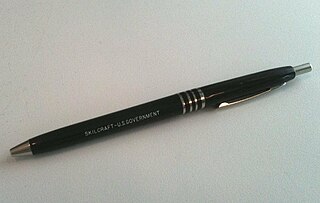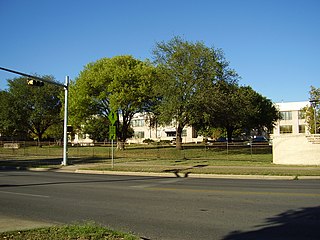Perkins School for the Blind, in Watertown, Massachusetts, was founded in 1829 and is the oldest school for the blind in the United States. It has also been known as the Perkins Institution for the Blind.

The Texas Department of Assistive and Rehabilitative Services (DARS) was a Texas state agency that was part of the Texas Health and Human Services Commission. The agency worked with Texans with disabilities and children with developmental delays to improve the quality of their lives and to enable their full participation in society.
TheChicago Lighthouse is a non-profit organization located in Chicago, Illinois.

Skilcraft, often stylized as SKILCRAFT, is the registered trade name of the National Industries for the Blind (NIB). Products made by Skilcraft are created largely by visually impaired or severely disabled individuals. Products bearing the Skilcraft brand are commonly used in United States federal government institutions, including the United States Postal Service. They are also commonly sold in U.S. military base exchanges and commissaries.
The American Foundation for the Blind (AFB) is an American non-profit organization for people with vision loss. AFB's objectives include conducting research to advance change, promoting knowledge and understanding, and shaping policies and practices.

L'Occitane en Provence, "the Occitan woman ," commonly known as L'Occitane, is a French luxury retailer of body, face, hair, fragrances, and home products based in Manosque, France. It was founded in 1976 by Olivier Baussan, with the purpose to create a company that celebrates and preserves the traditions of his native Provence. In 2010, the company became listed on the Hong Kong Stock Exchange. In 2024, controlling shareholder Reinold Geiger offered to take the company private.

Purell is an American brand of hand sanitizer invented in 1988, and introduced to the consumer market in 1997, by GOJO Industries. Its primary component is ethyl alcohol, and is used by wetting one's hands thoroughly with the product, then briskly rubbing one's hands together until dry.

The Texas School for the Blind and Visually Impaired (TSBVI) is a Texas special public school, in the continuum of statewide placements for students who have a visual impairment. It is considered a statewide resource to parents of these children and professionals who serve them. Students, ages 6 through 21, who are blind, deaf-blind, or visually impaired, including those with additional disabilities, are eligible for consideration for services at TSBVI.
The Javits–Wagner–O'Day Act 41 U.S.C. § 46 et seq. is a U.S. federal law requiring that all federal agencies purchase specified supplies and services from nonprofit agencies employing persons who are blind or have other significant disabilities. The Act was passed by the 92nd United States Congress in 1971 as a significant amendment to a prior act in 1938.
The Catalan Association for the Blind and Visually Impaired, with headquarters in Barcelona, is a non-profit organization, registered in the Registre d'Associacions de la Conselleria de Justícia de la Generalitat de Catalunya with the number 14,965 and declared of Public Utility by the Ministerio del Interior on December 29, 1997.

The Associated Services for the Blind & Visually Impaired (ASB) is a private non-profit organization in Philadelphia, Pennsylvania. It assists those living with vision loss to achieve independence through education, support services to advance necessary skills, and community connections. ASB collaborates with local, regional and national partners to provide additional resources and opportunities to clients.
Telesensory Systems, Inc. (TSI) was an American corporation that invented, designed, manufactured, and distributed technological aids for blind and low vision persons. TSI's products helped visually impaired people work independently with computers and with ordinary printed materials.

Gojo Industries, Inc., is a privately held manufacturer of hand hygiene and skin care products founded in 1946, in Akron, Ohio, where it is again headquartered after a period in Cuyahoga Falls. One of its most well-known products is Purell, a hand sanitizer. It offers an electronic hand hygiene monitoring system for medical institutions.

The Lighthouse of Houston is a private, non-profit education and service center dedicated to assisting blind and visually impaired people in the Houston, Texas metropolitan area to live independently. The Lighthouse serves approximately 9,000 people each year and is a member agency of the United Way of Greater Houston.

Lighthouse Guild is an American charitable organization, based in New York City, devoted to vision rehabilitation and advocacy for the blind. Its mission statement is "To overcome vision impairment for people of all ages through worldwide leadership in rehabilitation services, education, research, prevention and advocacy."
Columbia Lighthouse for the Blind (CLB) is an organization founded to help the blind or visually impaired population of the greater Washington, D.C., region, including the deafblind community, deal with the challenges of vision loss. The goal of CLB is to try to help people who are blind or visually impaired to remain independent, active and productive in society.
The Council of Schools and Services for the Blind (COSB) is a consortium of specialized schools in Canada and the United States whose major goal is improving the quality of services to children who are blind and visually impaired.
The LightHouse for the Blind and Visually Impaired is a San Francisco-based nonprofit organization, and is the oldest and largest of its kind in Northern California.

The Little Campus is a historic district and part of the University of Texas at Austin campus in Austin, Texas. Originally built in 1856 as the Texas Asylum for the Blind, the complex was used for a variety of purposes through the late nineteenth and early twentieth centuries. It was acquired by the University of Texas after World War I and listed on the National Register of Historic Places in 1974.

National Institute for the Empowerment of Persons with Visual Disabilities (Divyangjan), Dehradun is a premier organisation under the administrative control of Department of Empowerment of Persons with Disabilities (Divyangjan), Ministry of Social Justice and Empowerment, Government of India. Institute is training centre for the blind, located in an area of about 43 acres on Mussoorie-Dehradun Highway. It is also engaged in production of Braille literature, aids and appliances for visually disabled people. It also undertakes research and developmental activities ensuring emergence of disability inclusive policies, programmes and practices. The institute is governed by the Management & Advisory Bodies.











